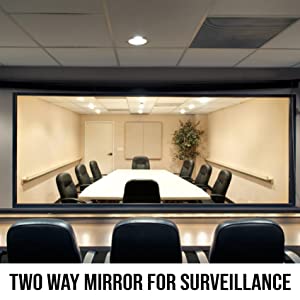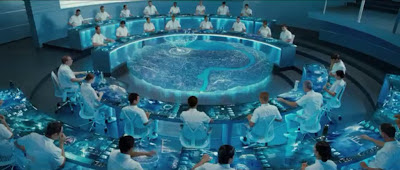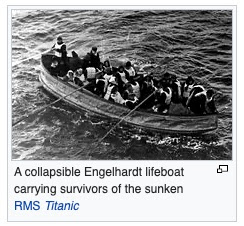Part 2 of Fake Prophets
 |
| Exhibit 1 |
“Thou shalt not raise a false report:…
Thou shalt not follow a multitude to do evil,…”
(Exodus 23:1a, 2a)
By Sarah H. Leslie
The Fake Religion
Fifty years ago I encountered a new false religion. I’d already been involved in a hybrid false religion, which was the unique form of
eastern mysticism popularized by the Beatles and other pop culture idols during the height of the hippie movement. Before that I had taken serious dives into existentialism and occultism.
This new fake religion promised wholeness and
self-actualization. It claimed it was on the verge of discovering how to remedy the human condition, elevate it to higher levels, and unify mankind. There were paths of
perfection to pursue—some
mystical, some
behavioral, some
technological—but oddly they were devoid of God. Man could heal himself. A religion
“without Christ… having no hope, and without God in the world” (Ephesians 2:12). A religion that denies
“the living God, the pillar and ground of the Truth” (1 Timothy 3:15).
For me, it all began in the Fishbowl.
 |
| Exhibit 2 |
FISHBOWL #1
It was midwinter 1972, a cold dreary day in the Midwest. The department of education building on campus was an antique brownstone covered in vines. Scuffed-up oaken steps noisily announced our entrance. When we arrived in the classroom, the one-armed wooden desks had been arranged in a circle. A small group of students were already sitting under the tall dingy windows rationing sparse sunlight.
The professor was well-liked by the students for his enthusiastic teaching style. This particular day at the front of the room stood several well-dressed men and a woman. They were introduced to us as professors from a southern state university. One name was so odd that we tried hard not to laugh.[1] Today, our professor announced, we would be put into a “fishbowl.” We would be going through a set of scripted exercises. These outside professors would be our observers looking in, examining our behavior.
The exercise began with an older student strategically sitting in the chair closest to the window. He asserted very confidently, “Black is white.” The student to his left, a stylish brunette, calmly agreed, “Black is white.” She turned and looked expectantly to the person on her left. That student, a sleepy-eyed young man, nodded and blandly stated, “Black is white.” To his left two more students asserted the same.
The sixth student seemed confused for a brief moment, then glanced around the circle. With wide eyes he gazed at the professor expectantly, shrugged his shoulders, and then blew it off. “Black is white,” he nodded. The student next to him, a sorority girl with blonde good looks, flippantly agreed. After that each student stated that black was white.
I was 18 years old and a fledgling Christian believer. I didn’t want to lie. I frantically wracked my brain with how to respond. Finally, I settled on a solution. With as much skepticism as I could muster in my trembling voice, I queried, “Black is WHITE?” This wasn’t a statement; I asked a question. After me everyone else resumed rehashing the narrative.
What had just happened? I had just experienced the first of many experiments on group psychology. The object of the lesson, we were told, was to demonstrate how easily people conform to peer pressure. As we discussed it with our professor, his associates still observing us in the fishbowl circle, it was divulged that the first five students had been privy beforehand to the ruse. The rest of the students, afraid to go against the group, rehearsed the same false statement.
Our educational psychology professor then proudly stated that the experiment had been a great success. His onlooking colleagues agreed. Everyone else seemed satisfied by the explanation. Except for me. I was discomfited. I knew that I had not violated my conscience, but I was deeply disturbed by my lack of courage to boldly stand up and state emphatically, “No, black is NOT white.” Plus, I didn’t know whether to be relieved or upset that my questioning response was ignored by the professor and his observers. They had just pronounced that we had all unanimously conformed. I hadn’t. Not exactly.
 |
| Exhibit 3 |
FISHBOWL #2
A few days later we trudged up snowy steps and back into the same dusty classroom. This time the professor had brought in his colleagues from the university. These professors were having a lively discussion with him at the front. He explained his peers were here to observe him as conducted our class. Once again, we were told we would be in the “fishbowl” as they all looked on.
We each took a number and were divided into approximately five groups of five students. The professor handed out an assignment to us, one per group. “This is going to be a fun exercise,” he announced. We scraped our desks into small groups into the corners of the room and poured over the instructions.
As the students in my group read our assignment our brows knit. Hmmmm. What was THIS all about? The instructions said that there were nine people in a small boat after a shipwreck. The boat was too tiny for everyone, so we needed to pick and choose which people would be cast overboard and which ones could stay in the boat so that it wouldn’t sink. We were provided with a detailed description of each person in the boat, their age, their occupation, and incidental details. I recall a nun, a teenager, a doctor, some type of a blue-collar worker, and an elderly man.
A bit uneasy, we began to make tentative suggestions. But each time someone talked about their selection preference, another group member would express a cautious dismay. Some personalized it – what if it was one of their family members? Finally, one of male students, a well-known athlete on campus, blurted out, “Ah-ha! I figured it out!” He told us he thought we were once again being tricked and that this was actually a small group assignment in creativity and ingenuity. Hadn’t the professor promised us this would be fun? Relieved, we began to feverishly work up a plan to save everyone on that boat. People could take turns in the boat. While some rowed, others could hang off the side. A few of the more feeble could be put to use, too. One student knew about boats and their equipment so he described how we could engineer some creative netting and oaring implements.
Satisfied with our amazing solution, we were all smiles. The professor, seeing our enthusiasm, called upon our group first. As we laid it out, his smile began to wane. He looked nervously back at his colleague witnesses. He gulped. “Uh, I don’t think you understood this exercise,” he said. “You were supposed to follow the instructions.”
We thought we had followed the instructions, we protested. We looked around the classroom and tried to get the other students excited about our solution to the problem. “We saved everyone’s life!” we bragged.
At that point, the professor stated blandly, “But not everyone was supposed to live.”
“WHAT?!” We were incredulous. Surely this couldn’t be.
Yes, the professor explained, the exercise was one in which we needed to determine who lived and who died. It was called “The Lifeboat Exercise.” And we had just majorly botched it.
That brought the house down. The class erupted. A few Jewish students were protesting that this assignment reminded them of the “final solution,” and one even stomped out. Later I heard she filed a formal complaint. Others rehearsed out loud the thought processes by which they had decided to kill – or not kill – their people in the boat. The more they said, the worse it got. There was no way to sugar-coat it. There was a dark cloud over us as we were dismissed that day.
WHAT HAD JUST HAPPENED?
I had just experienced the first generation of experimental educational psychology in the classroom. We were guinea pigs, experimented upon while observers took notes.
The fact that I vividly recall these two examples five decades later is a testament to the power of human conscience. Rather than my conscience becoming seared, i.e., desensitized, these two experiments awakened me. These two scenes would replay in my mind as one rugged life situation after another compelled me to choose truth over a lie, right over wrong, life over death, freedom over bondage. God’s Holy Spirit, a tiny flickering flame during that rocky period of my life, illuminated my sin-corrupted mind. I would fail, time and again, but then I would remember those two exercises. And with shame I would repent. And relentlessly I would research what had happened to me, and why, so I could avoid it happening again.
As I grew in the Lord, I learned that the Bible specifically warns that this manipulation is an end-time tactic of the devil to attack the conscience:
“Now the Spirit speaketh expressly,
that in the latter times some shall depart from the faith,…
having their conscience seared with a hot iron.”
(1 Timothy 4:1a,c)
καυτηριάζω kautēriázō, kow-tay-ree-ad’-zo; from a derivative of G2545; to brand (“cauterize”), i.e. (by implication) to render unsensitive (figuratively):—sear with a hot iron.[2]
In order to follow those Fishbowl instructions, we students needed to ignore our own eyes and ears. Logic, reason and rational thinking in our brains needed to be shut down. And in the second Fishbowl assignment we needed to ignore what the Bible calls “natural affection” (Romans 1:31; 2 Timothy 3:3). If we had been given this assignment in real life, we would have watched people screaming and flailing in the water as they drowned. The imaginary scenarios avoided that horror. But meanwhile we had been desensitized (cauterized, seared).
Without the conscience there can be no conviction. And without conviction we cannot stand. This fake religion provides no foundation upon which to
“Watch ye, stand fast in the faith, quit you like men, be strong” (1 Corinthians 16:13). Instead it coaches us to cave, flip flop and follow the foolishness of man. (See
“Conviction vs. Preference.”)
These Fishbowl exercises purposefully created
cognitive dissonance. It is not an accident that one Fishbowl assignment went before the second. First, we lied in order to conform to peer pressure—conscience corrupted. Second, our leader assigned us to work cooperatively to obey an insane-on-its-face instruction—conscience
seared. Was it any wonder that the Jewish students in my educational psychological class experiment got upset? They were the first generation born after the Holocaust and recognized this for what it was – blind obedience, conformity to brutal edicts, ignorance of facts, failure to question, belief in propaganda, and collectively killing.
 |
Exhibit 5: Watch HERE
|
SEARING THE CONSCIENCE
The overloaded “lifeboat in crisis” represented a dramatic shift in education from academics to psychology. The religious tenets of situation ethics and moral relativism were inculcated as a new value system into the pliable minds of children. The exercise—in which students were compelled to choose which humans were expendable and, therefore, should be cast off into the water—became a mainstay in elementary and secondary classrooms across the country. Creative solutions? Not allowed. Instructions? Strictly adhered to. In truth, there is only one correct answer to the Lifeboat drama: death.
In the late 1980s and 1990s this type of manipulative psychology was being built into newly-designed educational “assessment” tests administered to students in public school classrooms. These were not academic tests, but rather evaluated a student based on attitudes, feelings, beliefs, opinions and values. There was a “correct” answer, but it permitted no room for individual conscience or conviction. Here is a classic example from that period:
Anita Hoge, a concerned mother, exposed these connections in the early nineties. When researching Pennsylvania’s EQA (Educational Quality Assessments) and its relationship to the National Assessment of Educational Progress (NAEP), she noticed an alarming emphasis on group conformity as a mark of good “citizenship”….
She noticed that in the following NAEP’s test assignment, students were not given the option of saying “no” to vandalism — only to the three incentives. The context seemed to assume that — given the right incentives — all students would participate in the suggested lawlessness:

Guess what the “right” answers were? Hint: The state seeks responses that demonstrate “willingness to honor self-made commitments to individuals or groups.” This response falls into the “citizenship” category which measures “Personal responsibility and integrity.” Knowing that today’s global values give new meaning to words like responsibility and integrity, one can begin to understand why the desired answers would be “Yes” to 1 and 2.
The key is control, explained Anita Hoge. To transform nations, trained leaders must manage group behavior [via] periodic assessments of the student’s locus of control and rate of…. By using computers programmed according to each child’s needs, weaknesses, interests, felt needs, and resistance (or locus of control), they hope to mold citizens who can be managed through group pressure — even as the students are assured that they “own” their choices and think independently.
As churches become increasingly dependent on similar technology and continual assessments, they gradually adapt to the government process of surveillance, control and psychosocial manipulation through facilitated groups and dialectic thinking.[3]
 |
| Exhibit 6 |
LIVING IN THE FISHBOWL
This
testimony is a simplistic description for what has now evolved into very
sophisticated psycho-techno methods of human manipulation. Many of us have warned precisely about these things, with much documentation, for many decades.[4]
These key educational psychology exercises form
a basic foundation for all
subsequent tenets and practices of what has become a mass fake religion.
Today, the major social platforms in cahoots with big media empires can
produce astonishing results instantaneously simply by pumping out
propaganda that “down is up” and “wrong is right.” Technology helps to
alter the truth, tailor the message, collect the data, and surveil the
results through its fishbowl lenses. Education has pre-programmed students in classrooms for over five decades now to be 1) dumbed down academically, 2) unable to think logically or rationally, 3) susceptible to technological and media methods of altering brain and body chemistry, and 4) addicted to peer culture. (Read:
the deliberate dumbing down of america.)
Via
this fake religion’s pre-programmed AI (artificial intelligence) our opinions are shaped,
our beliefs are altered, our values are corrupted, our attitudes are
adjusted, and our behaviors are changed. The
entire system is based on a
downward spiral of endless operant conditioning – rewards for the
compliant, penalties for those who don’t conform. Technology empires are
now exercising their power to silence any who exhibit strength of
conviction and purity of conscience. The rationales for this are
indeed evocative of an
earlier regime.
 |
| Exhibit 7 |
THE FISHBOWL ARENA
The Lifeboat Exercise would later be re-cast into reality TV shows like Survivor—a daily drama, a continual shifting of the rules, a selection process, and a survival of the fittest. The purpose for Hollywood-izing the Lifeboat Exercise was to make it seem palatable, even normal to the masses. This psychodrama was an effective way to desensitize people into thinking this survival game was normal.
A few years later the fictional The Hunger Games books (Suzanne Collins) and movies depicted the Lifeboat Exercise in a way that was not sugar-coated. The domed arenas where the death game was played out was a giant fishbowl. Outside observers were calling the shots and manipulating the violent high-tech engineered variables inside the arena. All but one teen had to be killed, the selected participants were told, for the greater good of Society. The heroine found creative, desperate ways to “beat the system.” But the “system” was a death trap. It was rigged.
The Fishbowl aspect of the staged arenas in The Hunger Games also portrayed a more disturbing realism. The teenagers in the arena performed for an audience, the wealthy decadent populace which was addicted to the scary drama and gory violence. The entire event was super-scripted and hyper-staged to induce the maximum dopamine and adrenaline in the onlookers. Fantastical theatrics. But the deaths were real.[5]
Oh, where have we seen this before? It is no accident that the author of the series invented evocative names for the characters reminiscent of the Romans. Ancient gladiatorial contests and executions took place in an arena – an amphitheater. Onlookers got their jollies by watching the blood and gore. In this very environment the early Christians were tortured and brutally killed.
 |
| Exhibit 8: The Hunger Games Arena in the Fishbowl |
THE REAL FISHBOWL
The writer of Hebrews wrote about another arena, a different sort of Fishbowl. He invoked the image of an earthly arena where we have heavenly witnesses
“Wherefore seeing we also are compassed about
with so great a cloud of witnesses,
let us lay aside every weight,
and the sin which doth so easily beset us,
and let us run with patience the race that is set before us,
Looking unto Jesus the author and finisher of our faith;
who for the joy that was set before Him endured the cross,
despising the shame,
and is set down at the right hand of the throne of God.
For consider Him that endured
such contradiction of sinners against Himself,
lest ye be wearied and faint in your minds.
Ye have not yet resisted unto blood,
striving against sin.”
(Hebrews 12:1-2)
Just before these words, we find the “faith chapter” in the Bible, Hebrews 11. This is a listing of those who have gone on before us, who lived out their faith according to their conscience and conviction. They believed God’s promises quite literally. They obeyed God and not man. They looked for a heavenly reward, not temporary comfort. This heavenly perspective is desperately needed now that we are undergoing continual Fishbowl surveillance by an emerging antithesis-to-Christ system that is increasingly
threatening believers with ominous Lifeboat scenarios.
 |
| Exhibit 9: Roman Colosseum |
Examine yourself. Ask the hard question: Just how much of your life, your decisions are motivated not by Jesus Christ, but by fear of man. Consider your prayer life and your daily step-by-step walk of faith. How much of what you do, how much of how you act, how much of how you live is based not on Scripture or walking by the Spirit, but rather a fear of man.
Be encouraged to examine your hearts and stand fast. God has given you a conscience; make sure it is not seared. And do not falter or waver, but rather stand fast on Scriptural conviction.
“If any of you lack wisdom,
ask of God, that giveth to all men liberally,
and upbraideth not;
and it shall be given him.”
(James 1:5)
“The LORD is on my side;
I will not fear:
what can man do unto me?”
(Psalm 118:6)
“In God have I put my trust:
I will not be afraid
what man can do unto me.”
(Psalm 56:11)
Endnotes:
1. While working on the manuscript of Charlotte Iserbyt’s book in the late 1990s I was stunned one day to come across this person’s name in one of her entries; this person went on to become an education reform leader. At that moment I realized that I had been the subject of a psychological experiment. See: http://deliberatedumbingdown.com/ddd/deliberate-dumbing-down/ where this book can be freely downloaded: the deliberate dumbing down of america: A Chronological Paper Trail (1999, 2011) by Charlotte T. Iserbyt. This book chronicles the history of education reform, its system and its methods. These same methods of psycho-social-techno manipulation then came into the church and we have warned about them repeatedly on this blog since 2005.
3. These paragraphs and the accompanying chart are part of a key article in a series by Berit Kjos, “Who can Resist the Pull of the Crowd,” 2/24/10, http://www.crossroad.to/articles2/04/crowds.htm. See also B.K. Eakman’s landmark book Educating for the New World Order (Halcyon, 1991) which details Anita Hoge’s story and her early research. Anita Hoge would go on to be a prolific writer on the Internet and some of her articles are archived on New With Views: https://newswithviews.com/author/anita/
4. I
have spent the past thirty years warning specifically about these
things, with exhaustive documentation. Much of the collaborative
research we did early one can be found at Berit Kjos’s website www.crossroad.to. See also Dean Gotcher’s site www.authorityresearch.com for a deeper dive.
5. The current Wikipedia entry for “Fictional world of The Hunger Games” explains the name for this Fishbowl society is Panem: The word panem is the accusative singular form of Latin word for ‘bread’ and was derived from the Latin saying panem et circenses, meaning ‘bread and circuses’. The phrase is attributed to the Roman poet Juvenal and refers to the use of entertainment and plentiful food to make citizens give up their freedoms and political power…. Panem is a totalitarian society and a police state modeled somewhat on ancient Rome.” https://en.wikipedia.org/wiki/Fictional_world_of_The_Hunger_Games#Games [links removed].
Exhibits:










